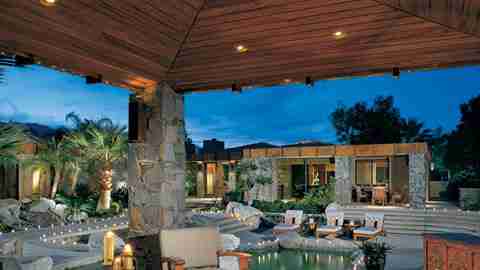Desert Orientation
View Slideshow

Each time I'm confronted with a new project," says designer Donna Livingston, "I look for one idea—one key concept—that can provide the inspiration for the whole house. In this case, it came to me as I was thinking about the gates for the main entrance."
The project in question is a spacious contemporary house built around a courtyard in Indian Wells, California, a desert resort town where emerald-green fairways punctuate the dusty chaparral and royal palms stand out in silhouette against the surrounding mountains.
"The house had been finished in conventional desert colors," says Livingston, "pinks and peaches—and the effect was rather bland. I wanted to find a way of giving the property a sense of richness and warmth, and a little drama, and the idea that popped into my head was to replace the plain entrance gates with copper gates decorated with a bamboo motif. To a large extent, everything evolved from that. That's when I began to think about the Asian theme. Not just a Japanese-style house or a Chinese-style house. Some thing more eclectic than that, bringing together Thai and Indian and Burmese pieces—art and furniture from all over the region. I thought of it as having what you might call Balinese chic."
In conceptualizing the house, Livingston had the advantage of having previously designed the clients' primary residence in Los Angeles, so she had a strong sense of their tastes. Whereas that house is traditional, their retreat was to be quite different: elegant, certainly, but also decidedly exotic.
To create the copper gates, Livingston called on Giminaro Studio of Crawford, Colorado, whose craftsmen rendered a pair of gates that would not look out of place in a Chinese imperial palace. The studio was also asked to trim the entire fascia of the building with copper as well as to provide doorframes and outdoor light fixtures.
As one enters the courtyard, the expanses of copper trim immediately catch the eye, emphasizing the horizontal structural elements of the building, which are punctuated by stone columns and by three shallow pyramids that project above the roofline. The courtyard itself, with its pool, its gazebo and its comfortable patio furniture, serves as a tranquil outdoor room.
THE OVERALL FEELING OF ASIAN ECLECTICISM IS FOUND EVERYWHERE.
Except where it is scattered with boulders and planted with palms, the courtyard is floored with limestone that extends into the building. In the living room, expansive windows look out across a small lake to a golf course. The view draws the eye, but so do the carefully orchestrated volumes and details of the room itself, which gains a sense of scale from the pyramid-shaped ceiling. Livingston had this ceiling—and matching ceilings in the dining room, master bedroom and gazebo—refinished with Brazilian canary wood, which exudes a warmth that permeates the entire space. The overall feeling of Asian eclecticism is found everywhere in the room's combinations of objects and furniture. A Tang Dynasty–style horse sits on a lacquered games table. An imposing Thai giltwood mirror reflects upholstered silk walls. A pair of Ming figures stand near the bar, which is dominated by an embroidered Chinese screen.
Unlikely but satisfying combinations of elements are also in evidence in the dining room, where the lacquered table and chairs are set off by the intricate patterns of a Tabriz rug, while a Burmese Buddha reclines on the built-in buffet beneath a framed early-nineteenth-century Japanese ceremonial silk textile. The same subtle juxtapositions are found in the master bedroom. The atmosphere there is almost Zen-like, the mood established by an early-eighteenth-century Japanese screen that depicts birds in flight.
In one of the guest bedrooms is what Livingston describes as a colonial Asian–style canopy bed, which evokes Bangkok or Rangoon. Chinese lacquered tables and a woven wallcovering add to the sense of being in some exotic location before the world was shrunk by jet travel.
"Being able to use first-rate rugs, fine woods, custom-crafted copperwork—that's an ideal situation," Donna Livingston says. "It's like being a chef—you want to be able to use the finest ingredients, because that will allow the quality to show up in the finished dish. It helps, too, to have clients who are involved with what you're doing. It was the clients who found the Ming figures that are in the living room. And beside the entertainment center, there's a beautiful Tang Dynasty figure of a courtesan."
In a sense, the proximity of that more than one-thousand-year-old figure to the electronic equipment sums up the character of the entire house. It is a place where modern amenities and traditional values coexist, an environment in which the practical blends comfortably with a magic that originated in distant lands.